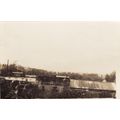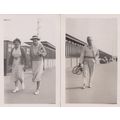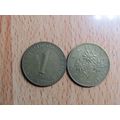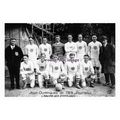Spalding, Lincolnshire - Parish Church - Valentines Sepia Type c.1940s
- Condition : Used
- Dispatch : 2 Days
- Brand : None
- ID# : 179902414
- Quantity : 1 item
- Views : 121
- Location : United Kingdom

- Seller : justthebook (+1703)
- Barcode : None
- Start : Sat 20 Apr 2019 12:51:17 (BST)
- Close : Run Until Sold
- Remain : Run Until Sold
More Listings from This Seller view all
Seller's Description
- Postcard
- Picture / Image: Parish Church, Spalding [Lincolnshire]
- Publisher: Valentines 'Sepiatype' - has quote from the 'Prime Minister' (so probably during the war)
- Postally used: no
- Stamp: n/a
- Postmark(s): n/a
- Sent to: n/a
- Notes / condition:
Please ask if you need any other information and I will do the best I can to answer.
Image may be low res for illustrative purposes - if you need a higher definition image then please contact me and I may be able to send one. No cards have been trimmed (unless stated).
------------------------------------------------
Postage & Packing:
Postage and packing charge should be showing for your location (contact if not sure).
No additional charges for more than one postcard. You can buy as many postcards from me as you like and you will just pay the fee above once. Please wait for combined invoice. (If buying postcards with other things such as books, please contact or wait for invoice before paying).
Payment Methods:
UK - PayPal, Cheque (from UK bank) or postal order
Outside UK: PayPal ONLY (unless otherwise stated) please. NO non-UK currency checks or money orders (sorry).
NOTE: All postcards are sent in brand new stiffened envelopes which I have bought for the task. These are specially made to protect postcards and you may be able to re-use them. In addition there are other costs to sending so the above charge is not just for the stamp!
I will give a full refund if you are not fully satisfied with the postcard.
----------------------------------------------
Text from the free encyclopedia WIKIPEDIA may appear below to give a little background information (internal links may not work) :
*************
Spalding is a market town with a population of 28,722 at the 2011 census, on the River Welland in the South Holland district of Lincolnshire, England. Little London is a hamlet directly south of Spalding on the B1172, whilst Pinchbeck, a village to the north, is part of the built-up area.
The town was well known for its annual Spalding Flower Parade, dating from 1959,[1] which attracted many regular visitors from around the world. The parade celebrated the region's vast tulip production and the cultural links between the Fens and the landscape and people of South Holland. At one time, it attracted crowds up more than 100,000, but attendance decreased to fewer than 40,000 in 2012.[2]
That year, two local councils announced they would no longer fund the parade, and the 2013 parade was the last.[3] Since 2002 the town has held an annual Pumpkin Festival, not linked to Hallowe'en, in October
Archeological excavations at Wygate Park in Spalding have shown that there has been occupation in this area from at least the Roman period, when this part of Lincolnshire was used for the production of salt. It was a coastal siltland. At Wygate Park salt making seems to have come to an end by the mid-3rd century AD; climatic change and flooding may have made such activities difficult, causing the practice to die out.[4]
The settlement's name is derived from an Anglian tribe, the Spaldingas, who settled in the area during the 6th century. They may have retained their administrative independence within the Kingdom of Mercia into the late 9th century, when Stamford became one of the Five Boroughs of the East Midlands under Danish control after years of invasion and occupation.
In John Bartholomew's Gazetteer of the British Isles (1887), Spalding was described as a:
"market town and par. with ry. sta., Lincolnshire, on River Welland, 14 m. SW. of Boston, 12,070 ac., pop. 9260; P.O., T.O., three Banks, two newspapers. Market-day, Tuesday. Spalding is an important railway centre, while the river has been made navigable to the town for vessels of from 50 to 70 tons. It is situated in a rich agricultural district, and has a large trade, by river and by rail, in corn, wool, coal, and timber. It has also flour, bone, and saw mills, breweries, and coach works. There are remains of a priory of 1501, a fine old church (restored 1860), a grammar school, a corn exchange, and a spacious market place."[5]
Listing Information
| Listing Type | Gallery Listing |
| Listing ID# | 179902414 |
| Start Time | Sat 20 Apr 2019 12:51:17 (BST) |
| Close Time | Run Until Sold |
| Starting Bid | Fixed Price (no bidding) |
| Item Condition | Used |
| Bids | 0 |
| Views | 121 |
| Dispatch Time | 2 Days |
| Quantity | 1 |
| Location | United Kingdom |
| Auto Extend | No |




 for 1 item(s)
for 1 item(s)

















